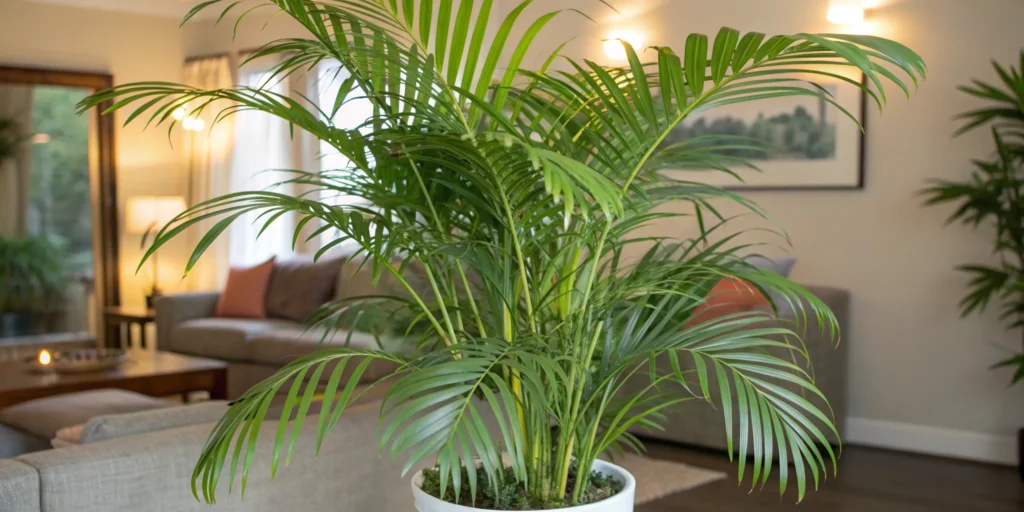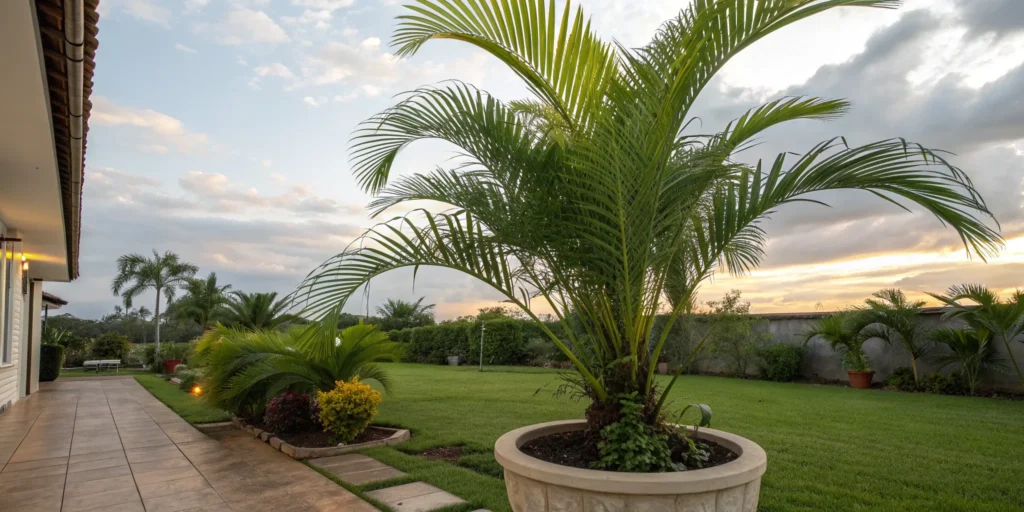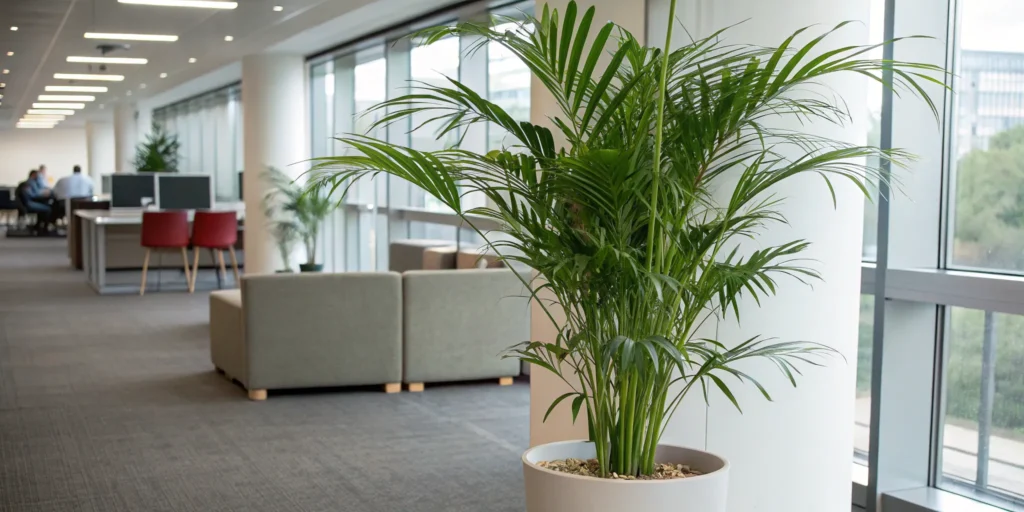Did you know that over a long period of time, the cost of owning a real Areca palm is more than four times the cost of a top-notch artificial one? Choosing between a real Areca palm and a fake Areca palm for your home or business is a pretty big decision, not just aesthetically, but also financially.
The Areca palm (Dypsis lutescens or Chrysalidocarpus lutescens) brings a tropical look to our homes and workplaces, but the truth is that these real plants require a lot more than they let on. The long-term costs of real plants are often underestimated. This guide gives you a detailed breakdown of the costs, and project timelines, to help you decide what’s best for your design and budget.
Initial Investment: Real vs. Faux Areca Palms
The first thing you need to consider is the initial outlay. But, even these initial costs vary a lot depending on the size, quality and origin of the plant.
Real Areca Palm Setup Costs
The initial cost of a real Areca palm can be quite a shock, depending on its size and maturity. A small potted Areca palm is cheap, but a big one for your living room, or a hotel lobby is going to cost you. Growing real Areca palm hedging structures for outdoor use is even more costly, especially if you need a specialist nursery to grow it.
- Plant costs: Expect to pay a pretty penny for a big specimen (7-10 feet tall). This is the starting point for all your future maintenance costs.
- Planter and drainage: Real Areca palms need big, fancy planters with good drainage to prevent the leaves going yellow and the roots rotting. These are expensive and need to be bigger than the plant itself to allow for growth.
- Initial supplies: You’ll need to buy special fertilizer, humidity trays, and soil mixes right away to start looking after it. All these extras add to the upfront costs.
- Shipping & installation: Transporting big real palms is complicated because they’re so delicate. This means labor costs for careful handling and getting it seated in its new planter just right to prevent the initial shock.

Quality Faux Areca Palm Price Range
The initial cost of a fake Areca palm is more than a real one, but this difference is made up for by the quality of the materials and the effort that goes into making it look as real as possible.
- Plant costs: A high-quality artificial Areca palm is more than a little pricey, but it’s made to look like the real thing, and will last a lot longer.
- UV resistant options: If you want it to go outside and withstand the sun, you’ll need to pay a bit more for the special coatings that protect it.
- Styling: Faux plants don’t need drainage, so you can get a lighter planter and place it on delicate flooring without worrying about damage. The styling costs are a one-off expense.
Installation and Setup Expenses
The difference in setup costs is massive. Real Areca palms are heavy and delicate, take a long time to get right, are prone to leaf damage and can go yellow within weeks if they’re not in the right conditions. Faux options, on the other hand, are lightweight, easy to set up and give you instant decoration that’s guaranteed to work out.
The Hidden Costs of Real Areca Palms
The real cost of owning a real Areca palm kicks in right after you’ve installed it. These ongoing costs are often overlooked, so you might end up going over budget in the long run.
Regular Upkeep Costs: Watering, Fertilizing, and Daily Care
To keep a real Areca palm looking its best, you’ll need to do a lot of expert-level upkeep on a regular basis:
- Watering: You’ll need to water it precisely, year-round, often daily in the summer or outside on a patio. If you miss watering, the leaves go brown; too much water and the roots rot.
- Fertilizing: You’ll need to fertilize it carefully several times a year to keep it growing and prevent the leaves going yellow.
- Cleaning and humidity: The big leaf surfaces get dusty and need regular cleaning to breathe and look natural. Misting them adds to the labor time.
The High Labor Cost of Pruning and Cleaning Yellowing Fronds
Yellowing leaves of the Areca palm represents its biggest maintenance issue. Even with flawless care, sooner or later, old fronds are bound to die off and suddenly your expensive, high-maintenance plant, requires very time-consuming and costly labor.
- Pruning: To keep an Areca palm looking its best, requires a bit of an expert hand when it comes to pruning. You have to carefully remove dead or browning fronds without ruining the new growth that’s coming in. This sort of specialized labor can drive up your long term maintenance costs.
- Debris cleanup: Since real plants are always shedding dead leaf matter, you can expect to be tidying up around the planter every single day, especially in high-traffic areas like hotels or restaurants where it’s just one more thing on an already long list of things to attend to.
- Repotting: As a relatively large plant, Areca palms need to be repotted into bigger pots every few years, which can be a great hassle, and the cost is not cheap.

Costs for Pest Control and Disease Treatment
Having real tropical plants around also means there’s a real risk of infestation and that is a financial and aesthetic nightmare, not to mention a risk to the entire design and look of the interior landscape. Real tropical palms, such as Areca and palmetto types are susceptible to pest infestation.
- Pest treatment: You’re talking about things like spider mites and scale here, those are a real pain to get rid of and require all sorts of chemical sprays or biological controls which, in homes or food establishments, can be pretty undesirable
- Disease: Then there’s the risk of root rot and other fungal diseases, which means even more time spent on diagnostic work, treatments and the total cost goes up still.
- Keeping sick plants isolated: Any plants that are infested need to be isolated immediately, otherwise you could well end up with a whole load of plants suffering from the same problem, which, for the design of the space, is just as bad as having a bunch of dead plants lying around.
Professional Care Services
A lot of commercial and residential Areca palm owners end up hiring professional maintenance services because the care is just too complicated or time-consuming for non-experts. It’s no surprise that the cost of this kind of specialized care, which includes things like watering, pest control, and pruning, can easily far exceed the initial purchase price within the first year alone. But the long term reliance on these professionals is a fixed and often underestimated expense.
Long-Term Value of Faux Areca Palms
When you look at the total cost of ownership over the long haul, you can see the advantages of the artificial Areca palm. It’s reliability and lack of recurring costs make it a much better investment for predictable design and budgeting.
Minimal Maintenance Requirements
A high quality fake Areca palm just needs to be dusted. There are zero upkeep costs related to water, soil, fertilizer, pruning or pest control. This means a huge reduction in labor costs for commercial businesses and a ton of extra time for residential homeowners. The artificial alternative offers guaranteed natural aesthetics with minimal commitment.
Durability and Lifespan
Artificial Areca palms are built to last. The long lifespan of false plants is the real key to their value and it really shows the quality of the materials used.
- Indoor lifespan: A good indoor imitation Areca palm (made from durable silk or polymer materials) can last 10 years or more with just occasional dusting. And because they are made to be resistant to indoor environmental stresses that can kill real palm trees.
- Outdoor lifespan: Outdoor artificial products, especially artificial hedges and screen plants, are treated with special UV resistant coatings to keep the green leaf color looking vibrant and resistant to fading or cracking under direct sunlight on a patio or balcony for 3 to 5 years and often longer depending on the intensity of the sun.
No Replacement Costs
One of the biggest financial differences between real and artificial plants is the rate of replacement. A real Areca palm often needs to be fully replaced every 1 to 3 years indoors because of browning, stress, or pests. But the artificial counterpart has zero replacement costs during its 5-10+ year lifespan, which makes the initial price of an artificial plant a great investment and eliminates a huge source of unpredictable expenses.
5-Year Cost Projection Analysis: Real and Faux Areca Palm
To make this financial contrast clear, we’ve put together a 5-year cost projection analysis for owning one large, tall (8-foot) Areca palm over a five-year period in a typical commercial office setting.
Real Areca Palm Total Cost
While a real commercial-grade Areca palm setup may cost $300 initially, the hidden costs are substantial.
Areca palms are notoriously difficult to maintain, requiring precise watering and caring. In commercial spaces, they typically require replacement every 12–18 months to maintain a fresh look. Over 5 years, replacement costs alone can exceed $1,000, not including the daily labor of watering and pest control.
Faux Areca Palm Total Cost
On the other hand, the total cost projection for the faux Areca palm over the same five years is just $200. This is based on a higher initial purchase price of $100- $200 for the high quality artificial Areca palm imitation, but where the artificial option really shines is in its negligible annual maintenance cost, just $30 over the five years for some minor dusting labor.
The superior lifespan and durability of the artificial counterpart also eliminates all replacement costs. By avoiding the upkeep and failure cycle of the real plant, the artificial option offers a low-expense solution that provides guaranteed aesthetic returns over the long term.

Breaking Even Point Calculation
Based on this clear comparison, the Artificial Areca Palm manages to hold its own against the Real Areca Palm within the first year, saving you a lot in long-term expenses over the course of five years. The total cost comparison makes it clear that the faux option is the better bet when it comes to environments where a ton of maintenance are required, giving you that financial predictability. This is the real eureka moment of most commercial designers the artificial plant is going to pay back in the first year.
Real vs. Faux Areca Palm: Making the Right Choice
The decision ultimately comes down to what your project goals are, what resources you’ve got at your disposal, and what the environment’s like. This section gives you a rundown of when the artificial counterpart really delivers the most value.
When to Choose Real Areca Palms
Choose real Areca Palms when:
- You really can’t get enough of the subtle movement and imperfections of a plant that’s 100% natural.
- The design location has just the right amount of bright, indirect sunlight and controlled humidity (that’s just what that plant needs to be happy).
- Your budget’s got some room in it for high maintenance costs, dedicated care staff, and regular replacements.
- The potted palm is located outside in a place with a mild, tropical climate where it can just thrive with a bit of minimal maintenance.
When Faux Areca Palms Are the way to go
If the artificial Areca Palm is what you’re after, it’s for good reason. It’s the clear winner when:
- The plant’s located in some high-traffic commercial space (like a hotel or restaurant), and you need something that’s going to last a long time and require minimal upkeep.
- The location’s got some pretty poor light or temperature fluctuations (like a bamboo office interior or basement residential room).
- You need to keep costs under control and make sure your budget’s looking rosy in the long run. That means the total cost comparison is going to be your best friend.
- Safety is a top concern (for you, your pets, or whatever). The artificial Areca Palm is going to give you a safe environment without any of the risks that come with toxic materials or spills.
- You need some instant privacy or a quick hedge that’s going to look great and last a while. If you are debating specifically between living plants and synthetics for screening, check out our guide on Areca Palm Hedge vs. Artificial Areca Palm. You can’t go past the artificial option when it comes to foliage aesthetics that are highly resistant to pretty much anything.

FAQs: Areca palm Cost Questions
What’s the average lifespan of a quality faux Areca palm?
A high-quality, commercial-grade faux Areca palm, will last 5 to 10 years indoors with basic cleaning. For a deeper dive into how long real vs artificial Areca palms last, check our detailed guide. Outdoor UV resistant ones will last 3 to 5 years in direct sunlight outside, depending on the materials and the climate.
How often do real Areca palms need replacement in indoor settings?
Due to light inconsistency, pests and air conditioning, real Areca palm indoor plants need to be replaced every 18 months to 3 years, adding up to a big total cost over time. This frequent replacement is the biggest hidden expense of real Areca palm hedge.
Are artificial Areca palms safe for pets and kids?
Yes, artificial Areca palms are pet safe and non-toxic. They are made of synthetic materials and don’t have any of the irritants, mild toxicity or messy soil/fertilizer of the real plant, making them perfect for residential use.
Conclusion
The price of a good artificial Areca palm is an upfront investment, but the long term savings are huge. The total cost comparison shows that real Areca palm hedging has massive hidden expenses for specialized care, pruning, pest control and frequent replacement.
By choosing the faux, you get immediate realistic tropical decoration and long lifespan and zero maintenance. The faux Areca palm lets you execute your design without worrying about brown fronds and hidden costs. Ready to stretch your budget and shrink your maintenance? Contact us today for a quick quote on our premium Areca palms and hedges!

